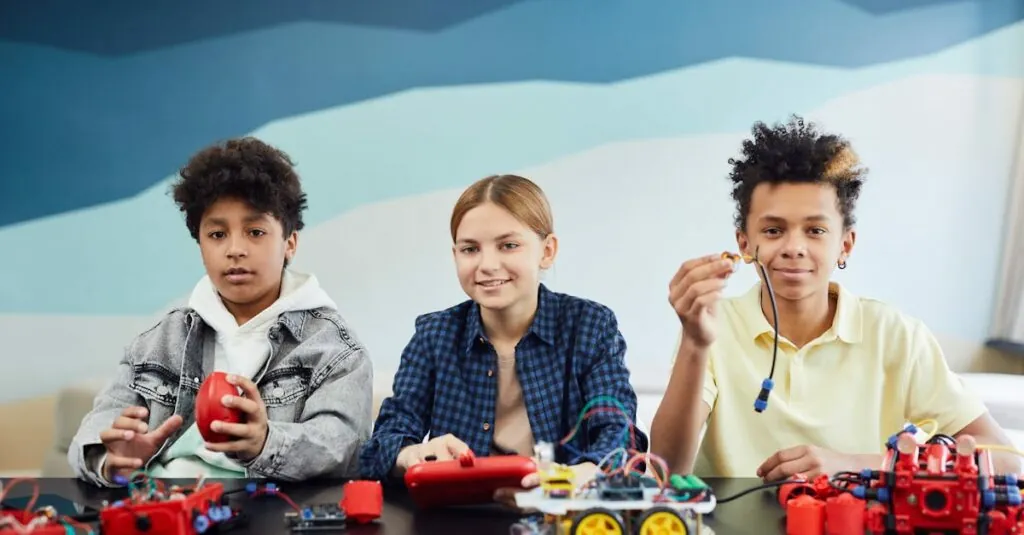Table of Contents
ToggleIn a world where kids are glued to screens, STEM robots are the ultimate game-changer. These nifty little machines don’t just entertain; they educate while sparking curiosity. Imagine your child building a robot that can dance, race, or even perform a little magic. It’s like giving them a backstage pass to the future, where creativity meets technology in a delightful mash-up.
Overview of STEM Robots for Kids
STEM robots for kids blend learning with fun. These innovative tools introduce concepts of science, technology, engineering, and mathematics in an engaging way. Children gain hands-on experience through building and programming robots. Creativity thrives as they explore design and functionality.
Many types of STEM robots cater to different age groups and skill levels. For younger children, simple robots like programmable toy cars enhance basic programming skills. Older kids can tackle more complex robots that require coding knowledge and critical thinking. Each challenge contributes to problem-solving and logical reasoning.
Skill development stands at the core of STEM robotics. Children learn teamwork while working on group projects. Collaboration fosters communication skills and encourages sharing of ideas. Essential life skills like perseverance and adaptability emerge when they encounter obstacles during projects.
Additionally, STEM robots are often integrated into school curricula. Teachers use these tools to complement traditional learning methods. Educational institutions report improved engagement and motivation among students when robotics is involved. Statistics indicate a notable increase in interest in STEM fields as students utilize robots for hands-on learning.
Innovative companies continually create new STEM robot kits, ensuring a vast selection for families. Major brands offer resources, tutorials, and online communities to support learning. Parents and educators can find valuable materials that enhance robotics experiences.
STEM robots provide exciting opportunities for children. They don’t just entertain; they engage young minds, laying a foundation for future learning and innovation. With diverse options available, every child can explore the world of robotics and STEM.
Benefits of STEM Robots
STEM robots provide numerous benefits that enhance a child’s educational experience. Engaging with these robots fosters curiosity and a love for learning, making educational concepts more appealing.
Enhancing Learning Engagement
STEM robots capture children’s attention, transforming traditional lessons into interactive experiences. These hands-on activities often lead to increased student involvement and retention of information. Engaging storytelling methods in programming and design encourage creativity, inviting kids to express their ideas. Many kids find themselves more motivated to participate in STEM subjects when robots are part of the curriculum. Interactive features enhance collaboration and problem-solving skills, allowing children to work together on projects and share their discoveries.
Developing Critical Thinking Skills
STEM robots challenge children to think critically when encountering design and programming tasks. These challenges promote iteration, where kids learn from mistakes. Analyzing problems and experimenting with solutions fosters resilience and adaptability in their thinking process. Many projects require children to strategize, encouraging logical reasoning and planning. These skills often translate into improved academic performance across various subjects, as students apply their critical thinking abilities in diverse situations.
Types of STEM Robots
STEM robots come in various forms, each designed to cater to different learning styles and age groups.
Programmable Robots
Programmable robots introduce children to basic coding concepts. They offer intuitive interfaces that allow kids to control their actions easily. Many models use simple block-based programming languages, making them accessible for younger users. This hands-on experience enhances critical thinking and problem-solving skills. Popular examples include the LEGO Mindstorms series and Sphero robots. These robots encourage creativity as children design specific tasks and challenges, fostering a sense of accomplishment.
Building Kits
Building kits provide a comprehensive experience in designing and constructing robots. These kits often include various components, such as motors, sensors, and structural pieces. Children can create unique robots while learning about engineering principles. For instance, kits like VEX Robotics and Makeblock promote teamwork and collaboration. These hands-on projects contribute to enhanced spatial awareness and mechanical understanding. Engaging with these kits encourages kids to experiment freely and learn from failures, solidifying their grasp on robotics and STEM concepts.
Popular STEM Robots for Kids
STEM robots engage young learners while providing hands-on experiences in science, technology, engineering, and mathematics. Choosing the right robot can enhance educational value and creativity.
Reviews of Top Models
LEGO Mindstorms series stands out for its versatility and user-friendly programming. This set allows kids to build unique robots and program them with drag-and-drop interfaces. Sphero offers interactive robots that teach coding through fun games and challenges, making learning enjoyable. Wonder Workshop’s Dash robot encourages creativity and collaboration, with a range of activities designed to reinforce STEM concepts. Each model includes tutorials and resources to guide children, ensuring they maximize their learning experience.
Age Recommendations
Younger children aged 5-8 benefit from simple, intuitive robots like Botley or Bee-Bot. These models teach fundamental programming concepts without requiring complex coding skills. Kids aged 8-12 thrive with programmable kits such as LEGO Boost or the Ozobot Bit, as they introduce intermediate coding and design principles. Advanced learners aged 12 and older can explore VEX Robotics or Arduino kits, which require critical thinking and offer extensive customization options. Selecting age-appropriate robots ensures a learning curve that matches each child’s skill level, maintaining engagement and motivation.
How to Choose the Right STEM Robot
Selecting the right STEM robot involves understanding the child’s interests and educational needs. Assessing various factors can lead to a more enriched learning experience.
Considerations for Parents
Parents should first evaluate the child’s age and skill level. Different models cater to specific age groups, with simpler robots ideal for younger ones. Safety features matter since younger children require safe materials and components. Budget considerations play a crucial role, as prices vary significantly among models. Engaging in conversations about preferred activities can also help identify the best fit. Researching user reviews provides insights into the robot’s ease of use and educational value.
Learning Objectives
Defining clear learning objectives enhances the effectiveness of using STEM robots. Parents might focus on problem-solving and coding skills for children aged 8 and older. Hands-on experience with building kits promotes teamwork and engineering principles. Introducing foundational concepts in programming can encourage creativity and critical thinking. Many robots, such as LEGO Boost or VEX Robotics, offer structured learning paths that align with educational goals. Engaging stories and interactive challenges foster curiosity and motivation in various subjects. Selecting robots that align with these objectives maximizes their educational potential.
STEM robots for kids represent a powerful tool for enhancing education and creativity. They not only make learning enjoyable but also instill essential skills that prepare children for future challenges. By engaging in hands-on activities with these innovative machines, kids develop critical thinking, problem-solving abilities, and teamwork skills.
Choosing the right STEM robot tailored to a child’s interests and skill level can greatly amplify the educational experience. With a wide variety of options available, parents can foster a love for learning that extends beyond the classroom. Embracing STEM robotics paves the way for a generation of thinkers and creators ready to tackle the complexities of tomorrow’s world.








